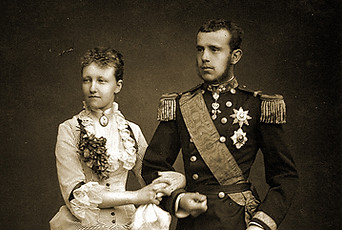

Menu
Potage à la Royale
Chicken consommé garnished with savory egg-custard pieces
Mayonnaise de volaille à la ravigotte
Poached chicken breast in a mayonnaise made from capers, mustard, herbs, white wine, veal stock, shallots and mustard
Rissoles à la modérne
Fried puff pastries filled with puréed foie gras and served with braised lettuce
Piêce de boeuf à la flamande
A Flemish dish using a round of beef casseroled in beer, onions and herbs
Poulardes à la Céléstine
Young chickens fried with mushrooms and tomatoes and then flamed with Cognac; dowsed in white wine; and served with dried garlic and chopped parsley
Petits pois à l'anglaise
Baby peas tossed with butter and parsley
Sorbet
Rein de chevreuil à la broche
Spit-roasted roebuck kidney
Beignets de chocolat glacés
Choux pastries filled with chocolate custard and glazed with chocolate icing
Gelée aux ananas
Pineapple jelly
Compote mêlée
Mixed poached fruits
Glaces
Ice-creams
Dessert

Gala Dinner at the Banski Dvori (Ban's Palace), Zagreb, hosted by Their Imperial and Royal Apostolic Majesties Emperor Franz Joseph and Empress Elisabeth of Austria-Hungary, on their Imperial Tour of the Kingdom of Croatia-Slavonia.
Thirty-one year-old “Sisi”, the legendary Empress of Austria-Hungary, accompanied her husband on an imperial tour of Croatia in 1869 that culminated in this banquet at the Banski Dvori (Ban’s Palace) in Zagreb’s Saint Mark’s square.
The tour marked a zenith in Emperor Franz Joseph’s efforts to bring about peace between his disparate and feuding Kingdoms. Hungary and Croatia, for which the Emperor was separately King of both, had an almighty fallout two decades earlier during the nationalistic revolutions of 1848.
Now a settlement had been reached. And as the imperial train crossed the border at nightfall, the Emperor and Empress entered their newly titled Kingdom of Croatia-Slavonia. It had been a 12-hour chug from Buda, in Hungary, along a rickety rail-track not designed for conveying imperial passenegrs.
Joining onboard the train was the ruggedly handsome Count Andrássy, who was the recently proclaimed Prime Minister of Hungary and integral to the peace settlement. Count Andrássy would attend this banquet too; and remained at the Emperor’s side for the entire three days in the Kingdom. His presence added fuel to innuendo of a romance with the Empress.
When the imperial train pulled alongside the platform in Agram (as Zagreb was called during the Habsburg era), the Ban of Croatia, who acted as Viceroy, was on hand for all the predictable ceremonial greetings, that were drowned out by the welcoming cheers of “zivios!” from the nearby crowds.
Imperial processions were rare in this city which The Times, in its coverage of the tour, delicately referred to as being “by no means famed for its wealth”.
The Ban also placed his residence at the disposal of the Emperor and Empress and so, for a few days, the baroque Banski Dvori was retitled the “Royal Residence” and served as the venue for this banquet.
The Emperor’s menacing security detail also came courtesy of his Croatian subjects.
“In the apartments occupied by their Majesties the bodyguard consisted of the Red Cloaks”, recounted the Austrian Foreign Minister on this trip, Count Beust.
“On the Emperor asking me what impression they made upon me, I said ‘I would rather meet them in the antechamber than in a lonely wood.'”
Earlier on this day Sisi – as the Empress Elizabeth was affectionately known – had visited the Sisters of Charity convent and hospital. Every step she took was preceded by young girls, in national costume, ensuring her pathway was strewn with flowers.
Meanwhile, Emperor Franz Joseph had spent the morning visiting his troops in nearby Belovar where he was heartily cheered in return for five days of bonus pay.
This would be the last night in Agram and, as evening fell, the imperial couple attended the theatre before hosting this gala ball and banquet. Sisi, dressed in her grande toilette according to the Weiner Zeitung, “deigned to be introduced and graciously address” the aristocratic ladies introduced to her by the Ban’s wife.
The menu offered guests a favourite of the Emperor: spit-roasted roebuck kidney, which Franz Joseph usually had served with redcurrant jelly.
The gilded menu-card was identical to those used at the Hofburg back in the imperial capital, Vienna.
When it came to preparing the table for a state dinner the Emperor’s aide-de-camp, Baron von Margutti, recalled how the palace menu-cards at each place setting:
"...were the finest product of the Viennese paper industry. Each had the imperial arms embossed in gold at the top. In accordance with an old custom at the Hapsburg court, the menus were always in French. As a rule the wines were not included”.
(NB. This menu had previously appeared on this website mistakenly as being from the Hofburg, in Vienna).
Kaiser Franz Joseph, aged 38, photographed in 1869
(the year of this menu)




Welcome to the Kingdom of Croatia-Slavonia
In March 1869 the French newspaper "L'Illustration" depicted the 38 year-old Kaiser Franz Joseph (left) being welcomed by the Ban of Croatia, Baron Levin Rauch de Nyék (right), two days before this banquet.
Imperial Wedding
In 1881 Kaiser Franz Joseph and Empress Elizabeth of Austria-Hungary hosted a wedding banquet at the Hofburg for the marriage of their son and heir to the throne, Crown Prince Rudolf to Princess Stéphanie of Belgium. The banquet started with pastries stuffed with a purée of larks' breasts topped with truffles.






